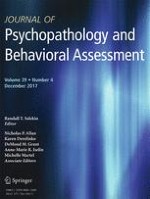14-06-2017
Methods and Functions of non-Suicidal Self-Injury among Adolescents Seeking Emergency Psychiatric Services
Gepubliceerd in: Journal of Psychopathology and Behavioral Assessment | Uitgave 4/2017
Log in om toegang te krijgenAbstract
Non-suicidal self-injury (NSSI) has been associated with an array of difficulties such as childhood abuse, interpersonal conflict, and mental health concerns ranging from emotional distress to suicidal thoughts and urges. To improve our understanding of NSSI and its relation to suicide risk, this study assessed the demographic (age, sex) and clinical (anxiety, depression, suicidal ideation, suicide attempt history) characteristics associated with NSSI methods (“how”) and functions (“why”). The study sample (N = 193) included youth and young adults, ages 13 to 25, who were seeking emergency psychiatric services and endorsed a lifetime history of NSSI. Study participants completed questionnaires assessing depression, anxiety, suicidal ideation, history of suicide attempt, and characteristics of NSSI engagement. Data were analyzed using Pearson, Spearman, and point-biserial correlation, Mann-Whitney U test, chi-square, t-test, and regression analyses (Poisson, binary-logistic, and ordinal). Female sex, the most prominent correlate in this study, was associated with number of lifetime NSSI incidents, quantity of NSSI methods used, and frequency of NSSI function engagement. Lifetime history of suicide attempt and suicidal ideation were positively associated with numbers of NSSI methods and functions, respectively. Regression analysis indicated that number of NSSI methods was associated with suicide attempt history, whereas total number of NSSI incidents was not. A greater understanding of the demographic and clinical factors associated with NSSI may ultimately advance the assessment and treatment of this behavior, especially in relation to suicide risk.
